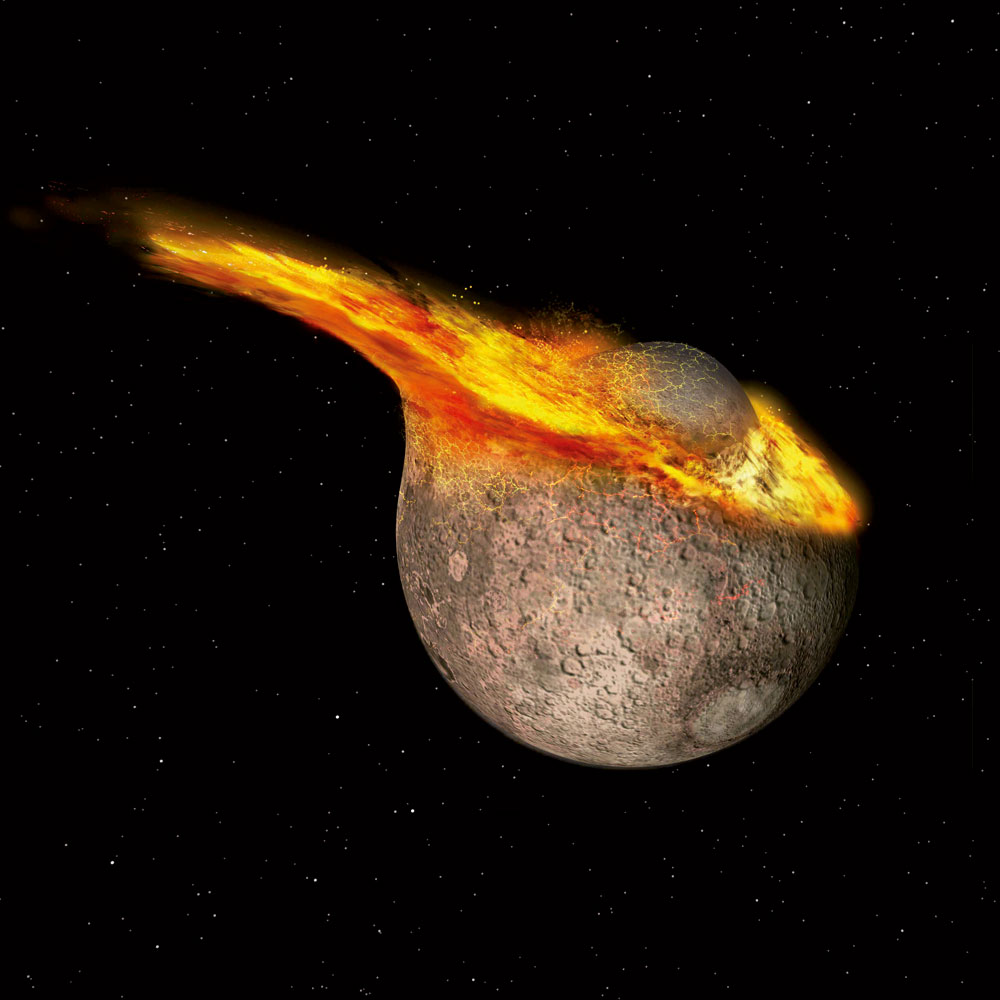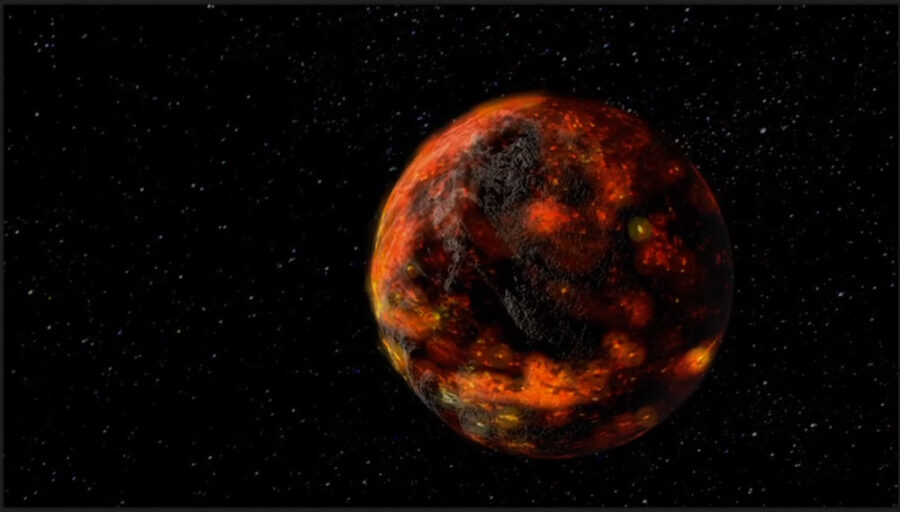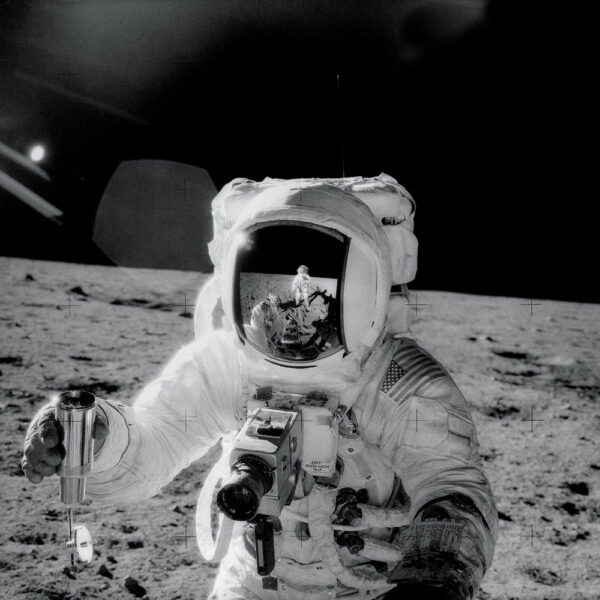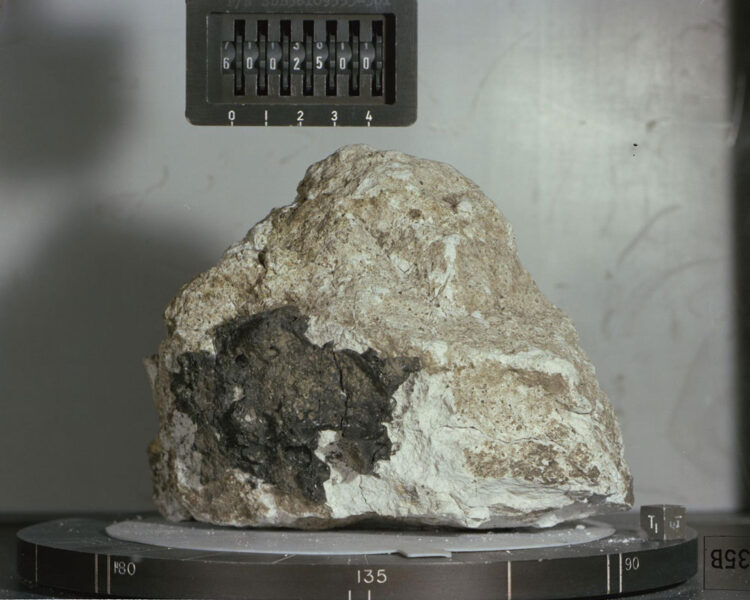The newly formed Moon might have taken up to 10 times longer to solidify than previously thought.
Most lunar scientists today think that the Moon formed after a Mars-size body hit the still-forming Earth, launching enough material into orbit to form our satellite. But there is still lively debate about the age of the Moon, and its evolution after it formed.

Ron Miller
A widely accepted possibility is that the Moon started its days in a molten state, covered by a magma ocean of unknown depth. New research shows that it could have remained partially molten for up to 200 million years, 10 times longer than previously thought.

NASA Goddard Space Flight Center
Earth is roughly 4.54 billion years old and its natural satellite is almost as ancient. In a paper published in Science in 2017, a group of researchers found that a bit of zircon recovered from samples ferried back to Earth during the Apollo 14 mission is 4.51 billion years old, becoming the oldest known piece of lunar rock.

NASA / JSC
Mineral dating, however, can only go as far back as the moment when those minerals formed, which happened at the end of the magma ocean’s crystallization. To really date the Moon, scientists need to figure out how much time elapsed until the magma ocean completely solidified — a task riddled with uncertainties.
“We are dealing with a lot of unknowns on the constraining factors here and also a lot of processes that we don’t know if they happen,” says planetary scientists Maxime Maurice (German Aerospace Center), who led the new study. “So the idea was to study thoroughly all the processes that could occur.”
To figure it out, Maurice and collaborators developed a new thermal evolution model — a detailed computer simulation — to reconstruct the first 200 million years of lunar evolution and find out how various parameters influenced the magma ocean’s crystallization. Their findings appeared online July 10th in Science Advances.
A Lid Kept It Warm
From all the processes the team considered, two previously overlooked aspects dramatically changed the outcome of the simulations: the insulating effect of the primordial lunar crust and considering that mantle convection probably started even before the magma ocean completely solidified.

DLR / M. Maurice
The first process slowed down the cooling rate of the magma ocean. Since the Apollo days, it’s been known that the molten Moon formed an early crust made of a light mineral called plagioclase, which floated atop of the magma ocean and solidified quickly.
“This white old crust on the Moon turns out to be an excellent blanket,” says planetary scientist Wim van Westrenen (Vrije Universiteit Amsterdam), who wasn’t involved with the study. “Its thermal conductivity is a lot lower than the rocks on Earth, and because of that it takes a lot longer for heat to leave the Moon to outer space.” While previous studies had accounted for this effect, van Westrenen explained, they had severely overestimated the thermal conductivity of the lunar crust.
The other key aspect that previous models hadn’t accounted for was mantle convection. The lunar magma ocean solidified from the bottom up because high pressure at depth forced the magma to solidify even at high temperatures. This process likely solidified 80% of the magma ocean within 1,000 years of the Moon’s formation. If mantle convection started at this point, it could have allowed heat to continue flowing from the depths toward the surface, keeping the magma ocean hot and molten.
On Earth, mantle convection creates the magma that feeds volcanoes. “In this case, it would be exactly the same, but the volcanoes would have spilled their lava into the magma ocean,” Maurice explains.
Until now, van Westrenen says, most lunar evolution scenarios assumed that mantle rocks didn’t start moving until the magma ocean had completely solidified.
According to van Westrenen, the combination of these two processes makes a huge difference for the longer-term survival of the magma ocean.
A Slightly Younger Moon?
Determining the duration of the lunar magma ocean can, in turn, help determine the real age of the Moon, which the team places between 4.40 and 4.45 billion years.
“The fact that the magma ocean was long-lived also influences how we can infer the age of these rocks,” Maurice says. “What we have found now is that the Moon might have formed much later than previously thought, as much as 100 million years.”
Mineral dating relies on isotopic “clocks” — measurable ratios of isotope pairs that change at known rates. According to Maurice and his colleagues, a slowly crystallizing magma ocean could have altered the initial ratios of these isotopes in the minerals, thus requiring a recalibration of these clocks. This, the researchers argue, could render the commonly accepted 4.51 billion-year age too old.

NASA / JSC / AACO
The finding opens the door to a reinterpretation of mineral isotope dating of many lunar samples, and, ultimately, for the age of the Moon-forming impact, Maurice says.
“Of course, you only need one grain in the Moon to be older than 4.45 to say ‘okay, that’s a nice paper but it's wrong,’” van Westrenen cautions.
“It is definitely true that there are still significant uncertainties in the rock dating that people do,” van Westrenen adds. These are very delicate measurements that just a few laboratories in the world can do, but even then, there are many assumptions guiding the final age calculations. “What this paper does very nicely is to give a good argument of why maybe you could interpret that zircon’s age differently.”
Editorial note: We've updated a quote from the lead researcher to clarify that the Moon formed 100 million years later than previously thought.
 2
2
Comments
Rod
July 17, 2020 at 10:48 pm
I have followed a number of reports on this new younger age for the Moon. Real constraints on the formation model(s) appears now for evolutionary scenarios for the origin of the solar system. 4.568E+9 years old is the oldest accepted time for the dust grains and proto-Sun began to form according to this abstract, https://ui.adsabs.harvard.edu/abs/2010NatGe...3..637B/abstract. The oldest dated Earth rocks are Jack Hills zircons, some 4.39 or 4.4E+9 years old, according to radiometric age. The Moon is now dated perhaps 4.45E+9 years old. Giant impacts also can erase the proto-earth primordial atmosphere too, https://phys.org/news/2020-07-supercomputer-reveals-atmospheric-impact-gigantic.html
Things are getting real tight to fit together now 🙂
You must be logged in to post a comment.
Rod
July 17, 2020 at 10:51 pm
https://ui.adsabs.harvard.edu/abs/2010NatGe...3..637B/abstract
This has the correct link for the 4.568E+9 years old dust grains for the beginning of the solar system.
You must be logged in to post a comment.
You must be logged in to post a comment.